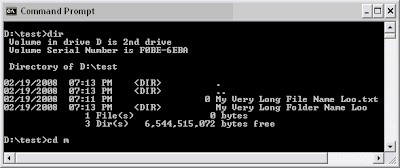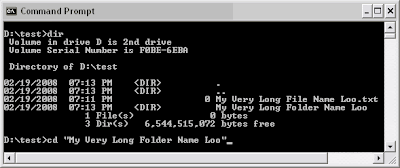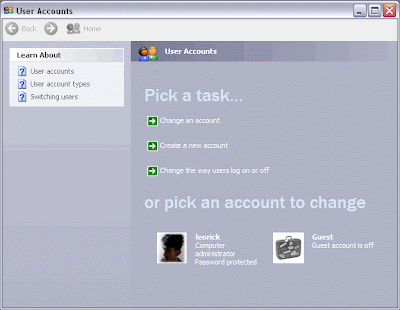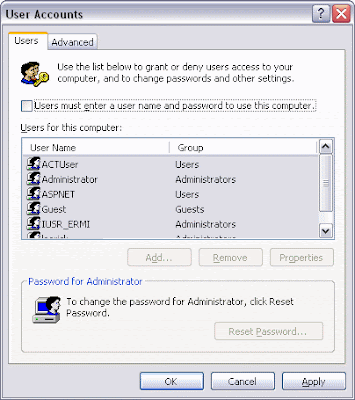Wednesday, February 20, 2008
Recreate Show Desktop Icon
Show Desktop icon near the Windows XP start button is used to minimize all active windows. The icon/button is located on your Quick Launch bar. This Quick Launch bar folder location is at %appdata%\Microsoft\Internet Explorer\Quick Launch.

Sometimes, people accidentally deleted this icon. To recover this icon/button, you can try to;
- Copy the icon from other users %appdata%\Microsoft\Internet Explorer\Quick Launch folder.
- Copy the icon from others machine with Windows XP that still have it on the same location.
- Search the icon entire drive for Show Desktop file (*.scf extension)
- Search the icon in i386 folder from Windows XP installer CD or DVD.
- Create a new icon/button.
[Shell]
Command=2
IconFile=explorer.exe,3
[Taskbar]
Command=ToggleDesktopRemember to save the file with .scf extension. If everything goes well, the file icon should appear as below automatically.
Tuesday, February 19, 2008
Automatic Completion with a Command Prompt in Windows
UNIX like auto complete is now available on Windows. I believe it is available since Windows 2000. Some versions of Windows do not turn this on by default. It is very useful whenever you are working with a very long file or folder name. Example;
You have a long folder name and you want to change directory into it. Just type cd m and hit TAB key should complete the long folder name automatically for you as below;

Useful isn’t it? To enable this feature, open the regedit and add "CompletionChar"=dword:00000009 to [HKEY_CURRENT_USER\Software\Microsoft\Command Processor] as below;

From screenshot above, CompletionChar is set to 0x9, that is the TAB key. If you want to customize you own choice of key, you might want to try 0x4 for Control+D or 0x6 for Control+F. For more info please visit
Microsoft - Help & Support.
Thursday, February 14, 2008
Windows XP Hidden User Accounts Interface (control userpasswords2)
Having more than one person using your computer? If you do, you can create user accounts for everyone so that they can customize their favorites, colors, wallpaper, and private files. Default ‘Windows XP User Accounts’.
Sometimes you might need to fine tune the user accounts. You can do this with a hidden ‘User Account 2’ interface by running control userpasswords2.

This ‘Windows 2000’ style ‘User Accounts’ might be useful for those users that are very familiar with Windows 2000.

So, now you might want to add this shortcut permanently to the ‘Control Panel’. The only way is to add some lines into the 'Windows Registry'.
It is recommended to use *.reg script below to add ‘User Accounts 2’ shortcut to your control panel rather than entering it manually. Copy lines below to a new file and called add_ua2.reg. Note that the extension must be reg. Just right click the file and Merge it. Your computer must be restarted for these to take effect.
Windows Registry Editor Version 5.00
[HKEY_CLASSES_ROOT\CLSID\{18646F66-8C25-0000-BEE4-C2CE1298969D}]
@="User Accounts 2"
"InfoTip"="Starts The Windows 2000 style User Accounts dialog"
[HKEY_CLASSES_ROOT\CLSID\{18646F66-8C25-0000-BEE4-C2CE1298969D}\DefaultIcon]
@="%SystemRoot%\\\\System32\\\\nusrmgr.cpl,1"
[HKEY_CLASSES_ROOT\CLSID\{18646F66-8C25-0000-BEE4-C2CE1298969D}\Shell\Open\command]
@="Control Userpasswords2"
[HKEY_LOCAL_MACHINE\SOFTWARE\Microsoft\Windows\CurrentVersion\Explorer\ControlPanel\NameSpace\{18646F66-8C25-0000-BEE4-C2CE1298969D}]
"Default"="Add Userpasswords2 to Control Panel"Just incase you don’t like it, you can also remove it using *.reg file below. Copy lines below to a new file and called delete_ua2.reg. Note that the extension must be reg. Just right click the file and Merge it. Your computer must be restarted for these to take effect.
Windows Registry Editor Version 5.00
[-HKEY_CLASSES_ROOT\CLSID\{18646F66-8C25-0000-BEE4-C2CE1298969D}\DefaultIcon]
[-HKEY_CLASSES_ROOT\CLSID\{18646F66-8C25-0000-BEE4-C2CE1298969D}\Shell\Open\command]
[-HKEY_LOCAL_MACHINE\SOFTWARE\Microsoft\Windows\CurrentVersion\Explorer\ControlPanel\NameSpace\{18646F66-8C25-0000-BEE4-C2CE1298969D}]
Subscribe to:
Posts
(
Atom
)



